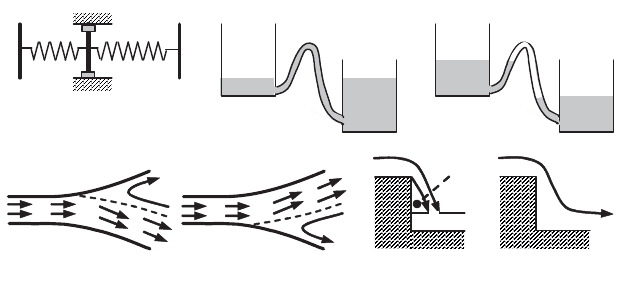Peube J-L. Fundamentals of fluid mechanics and transport phenomena
Подождите немного. Документ загружается.


Measurement, Representation and Analysis of Temporal Signals 403
about 100 m/s
-1
), whereas the smallest problem of heat transfer generally involves
fluctuations of some about 10°C. For example, a local, instantaneous measurement
sensor of velocity or of temperature characterizes phenomena associated with the
flow and the heat transfer depending on the circumstances (section 7.2.4).
On the other hand, the
respective contributions
a
p
G
of the acoustic modes and
c
p
G
of the convective modes to pressure variations may be of the same order. In
effect, we have seen (section 5.3.2) that we have:
– on the acoustic characteristic curve:
aa
ucp
G
U
G
|
– on the convective characteristic curve:
0
VVp
c
G
U
G
The ratio of these pressure fluctuations is thus:
V
u
MV
u
V
c
p
p
aa
c
a
G
G
G
G
G
G
1
|
As the Mach number is small at low velocity (M ~ 0.05 to 0.15 in ventilation
problems for example), the factor
M1 is quite large and it compensates the small
acoustic velocity fluctuations compared to the turbulent velocity fluctuations. This
results in
pressure fluctuations due to local turbulence effects, which are of the same
order of magnitude as acoustic pressure fluctuations.
A pressure probe (microphone) measures the local pressure independently of its
origin
and without knowing on which characteristic curve it is transmitted: it is no
longer possible to distinguish acoustic fluctuations from those due to local velocity
fluctuations. This problem is well known to those who measure sound: a
microphone placed in a flow does not only measure noise. Listening to the pressure
signal acquired by a microphone placed in the wind we are immediately aware of a
parasite “sound” due to the wind. This “sound” is not of an acoustic nature, but
rather a signal that corresponds to local pressure fluctuations associated with the
flow created around the microphone. Measurement of sound in the presence of wind
requires suitable precautions in order to reduce the impact of parasitic phenomena
(for example, “anti-wind” foam covers on microphones).
The separation of turbulence and acoustic pressure components is an important
and extremely difficult problem, since it corresponds to Navier-Stokes solutions for
which the theory of characteristics curves is in practice not applicable. This
404 Fundamentals of Fluid Mechanics and Transport Phenomena
separation between acoustic and turbulence signatures can only be made possible if
additional information is available: for example the periodic sound due to a
propeller can be extracted from a signal containing random turbulence fluctuations.
7.4.4.4.
The study of unsteady flows
The velocity, pressure or temperature fields associated with unsteady flows are
now accessible by means of experimental methods described in section 7.2.6.3; on
the other hand, the different methods of time-frequency analysis allows the temporal
and spectral characteristics of flows to be identified. These modern methods allow
us to consider the vast domain of experimental unsteady fluid mechanics, provided
that experiments can be performed in a reproducible manner (which means that
different realizations obtained are identical (section 7.2.6.3)). The identification of
unsteady flow structures and, in particular, the dynamics of vortex interactions
constitutes a domain of study which is relatively unexplored.
We will see that turbulence, being by its nature unsteady and broadly 3D, is
largely the result of interactions between inviscid fluid structures (turbulent energy
cascade [MAT 00]). The origin of turbulence is furthermore associated with the
development of flow instabilities issued from pre-existing perturbations. The
elementary mechanisms of these highly unsteady interactions are poorly understood.
For these reasons, we have focused on signal-processing and experimental methods
that can be used in a broad range of applications where unsteady phenomena are
encountered in possibly rotational flows These methods allowed for example the
acquisition of experimental data for the problem discussed in section 5.6.2.
Chapter 8
Thermal Systems and Models
This chapter is dedicated to the modeling of systems. The perspective developed
in automatic control and the corresponding methods are outlined. In addition to the
mathematical properties of thermodynamic balance equations and the measurement
and signal processing problems, these provide a general framework for the study of
the representation and evolution of physical systems. Using some basic heat
conduction problems in media at rest, the methods can be easily proved on account
of the linear properties that these present.
8.1. Overview of models
8.1.1. Introduction and definitions
In Chapters 1 to 4 we studied how to describe a physical system in the context of
thermodynamics. The equations for continuous media are hardly useable except for
very simple problems and any more complex system can only be represented by
making approximations, which it must be possible to evaluate. We will limit
ourselves in this chapter to state representation in which a given thermodynamic
system is represented as a group of sub-systems in instantaneous equilibrium. This
makes it possible to define the state variables of each sub-system. The partial
differential equations which represent the continuous medium are thus replaced by
partial differential equations describing the evolution of a restricted number of
variables. The general study of systems is derived from automatic control and signal
processing which provide, as in thermodynamics, general principles which cannot be
ignored. We will recall here the ideas that are necessary for the establishment of

406 Fundamentals of Fluid Mechanics and Transport Phenomena
models in fluid dynamics and heat and mass transfer, by limiting ourselves to the
study of thermal systems, whose damped character simplifies the discussion.
A system is a material ensemble that exchanges quantities with the exterior. We
act on the system(s) by means of inputs, which are imposed variables (a
temperature, a mass flow, pressures, etc.); these inputs lead to modifications of the
system which are manifest in observed and measured effects, which constitute the
outputs of the system. The inputs are therefore causes and the outputs are
consequences.
Syste
m
OutputsInputs
Initial conditions
Figure 8.1. Scheme of a system
A system is said to be causal (with respect to a variable) if the conditions which
determine its state and its outputs for a value of the variables x
0
result from data for
values of the variable x which are less than or equal to x
0
. This idea of causality
simply translates the mathematical properties associated with the parabolic or
hyperbolic character of the system towards certain variables or groups of variables
of the model that is used. While it is obvious for the time dimension (section
1.1.1.3), this idea, which is used in automatic control and signal processing, can also
be applied to transport and propagation phenomena (sections 5.3.2 and 5.4.5.4).
The description and knowledge of a system can be achieved by means of a
model, which can only be established if the system is observable, in other words if
we can measure the data necessary for its establishment. This condition obviously
depends on the nature of the system and the objective of the modeling.
The control of a system is an action that is often necessary for diverse reasons:
control of temperature in a zone, of a flow structure, a sound level, etc. A system is
said to be controllable if, from any initial state of the system, it is possible to act on
certain inputs in order to bring the system to a desired state.
A system is said to be instantaneous if its state and its outputs at a given instant
depend only on the inputs at that instant. This definition can be applied to any
system whose sub-systems are in mutual thermodynamic equilibrium. A system is
said to be dynamic if it is not instantaneous.

Thermal Systems and Models 407
Systems exhibiting hysteresis present the particularity that the stationary solution
corresponding to fixed inputs depends on their history (state variables at the initial
state and the past evolution of the inputs). Let us take the example of an oscillator
comprising a mass P placed between two springs and subjected to a friction force on
a fixed wall. If the friction is caused by a fluid, the equilibrium position of the point
P is unique, the tension in the springs being therefore equal. In return the existence
of a solid source of friction in P means that the final position of the point P also
depends on the movement history (Figure 8.2a).
Flow systems with hysteresis are encountered not only with fluids whose
behavior laws involve a solid friction (Bingham fluid), but also for Newtonian
fluids. This phenomenon is thus associated with the existence of two possible steady
solutions for a flow with fixed conditions. This circumstance may be due to diverse
phenomena such as the feeding of a siphon (Figures 8.2b and 8.2c), reattachment of
a flow on a curved surface (Figure 8.2d and Figure 8.2e), the flow of water over a
weir depending on whether the sheet of water is aerated (or ventilated) or not
(Figure 8.2f and Figure 8.2g), etc. The observed solution can vary depending on the
manner we seek to achieve it by.
A
P
B
(a) (b) (c)
(d)
air
water
(g)
water
(e) (f)
Figure 8.2.
Systems with hysteresis – (a) springs with dry friction; set of 2 tanks with feuded
(b) or not (c) siphon; flows in a divergent pipe (d) and (e); weir with aerated water sheet (f)
or non-aerated water sheet (g)
In addition, unknown perturbations (noise) are always present to varying degrees
in these inputs and can have diverse effects (“instabilities”). The idea of a stable
system is difficult to define, because it depends on the nature of the applied
perturbations and the properties of the response of the system. Stability is a complex
problem and of extreme importance in fluid mechanics ([SCH 99], [YIH 77]).

408 Fundamentals of Fluid Mechanics and Transport Phenomena
A system is said to be stationary or time-invariant if the outputs corresponding to
a given set of inputs do not depend on the instant at which the inputs are applied.
The equations of a time-invariant system are not influenced by a change of the time
origin. Systems whose structure and physical properties only depend on the state
variables are time-invariant. The same is not true of systems whose parameters
1
depend on external conditions which vary with time (for example, the flow of a
liquid in the process of polymerization, the action of an obstacle with an incidence
angle D(t) which is imposed in accordance with some external law, etc.).
A linear time-invariant system (LTIS), which is also known as a linear
stationary system (LSS), presents in addition the property of linearity: effects
proportional to the causes which produce them. These systems are described by
constant-coefficient linear models. Apart from some very specific cases, a system
with a non-uniform flow is not linear. The heat transfer of mass by diffusion is often
linear, even in flows, provided the temperature or concentration does not cause the
physical properties of the fluid to change. Coupling between different phenomena
and in particular chemical reactions in flows suppresses this linearity property. The
reader can verify these properties for the general equations in Chapters 1 to 4.
8.1.2. Modeling by state representation and choice of variables
In automatic control, state representation of a discrete system is a model of the
form [8.1] which represents its evolution:
UEXDYUBXA
d
t
dX
.... [8.1]
The state vector X is a set of n variables which characterize the state of the
system. The state representation is also called the internal representation. This
definition is no different in principle to the definition which was given in Chapter 1
where extensive and intensive variables were used as state variables. However, in
automatic control the components of the vector X can be any variables which
characterize the state of the system. The matrix A is a square matrix of rank n. It
characterizes the make-up of the system and of the sub-systems which correspond to
the choice of the state vector X.
The vector U is the input vector; it is of dimension p and corresponds to different
actions on the system. It does not in general have the same dimension as the vector
X, and the matrix B is a rectangular matrix of dimension n
*
p.
1
I.e. the coefficients of operators in the equation; the inputs are not parameters of the system
here.

Thermal Systems and Models 409
The vector Y is the output vector; it is of dimension q and it comprises the
different results desired for the problem posed. It does not in general have the same
dimension as the vectors X and U. In what follows, we will take E = 0 (the system is
thus called proper).
The representation of the state of a system is not unique as the variables can be
chosen in different ways or can be modified by changes of variable. Furthermore,
the components of the state vector can be related when we are limited to particular
operation regimes as we will see on numerous occasions in the remainder of this
chapter (section 8.3, section 8.5 and section 8.6). However, the systems studied in
this work are constituted of a matter, which obeys the laws of thermodynamics. The
form of differential system [8.1] is analogous to that of the balance equations, but
the coherence with the laws of thermodynamics is only effective because of a
suitable choice of state vector components (section 1.2.1).
We also saw in section 5.1.1 that a system of first order differential equations
can be written in the form of a scalar differential equation of order n for one scalar
variable. This equation can also be written in the form of differential system [8.1],
the state vector X (t) being replaced by a state vector having the same number of
components, but constituted of a variable x
1
( t) and of its n – 1 first derivatives. By
reconsidering the calculation of section 5.1.1 the reader will see that the inputs
obtained for this differential system imply the initial inputs and their n – 1 first
derivatives. This form of state-representation is known as the form of observability
([DOU 95], [GUP 83], [KUO 02]). We will use this for a particular case in section
8.4.2.2.
For a non-linear system the matrices A, B and D can be functions of the state
vector X of the system.
For a system involving an instantaneous response, the derivative
dtd
takes on
small values compared with second order terms; the inertia of this system is weak
and the extensive quantities which result from the inputs are instantaneously
transferred to the sub-systems. The differential character and the idea of the initial
state of system [8.1] have disappeared and the representation is reduced to an
algebraic system:
XDYUBXA .,0..
We note that in the case of an impulse input, the response and the outputs of an
instantaneous-response system involve a discontinuity. As nature does not contain
discontinuities in such situations, we have in reality a continuous transitional regime
involving a singular perturbation (section 6.4.3).

410 Fundamentals of Fluid Mechanics and Transport Phenomena
In the case of a time-invariant system, the coefficients matrices A, B and D are
independent of time, but they may be functions of the state variables: the structure of
the system remains unchanged over the course of time. If the system is furthermore
linear, they are constant and we have a time-invariant linear system.
For a system made up of continuous media, the system of differential equations
[8.1] is replaced by partial differential equations. The inputs are either boundary
conditions or volume heat source terms. When the physical properties depend on the
temperature, these equations are non-linear. On the other hand, if the properties are
only a function of the coordinates, we have a time-invariant linear system. In the
presence of a flow, the temporal derivative
t
ww
becomes a material derivative
dtd in the case of a Eulerian representation.
8.1.3. External representation
The external representation of a system consists of considering it as a black box
that links inputs and outputs. However, the conservation laws of extensive quantities
must be considered between the inputs and outputs of a system. The permanent
production of mechanical or thermal energy is only possible if energy is provided to
the system; the same goes for mass, chemical species in the absence of chemical
reactions, etc. The consequences of the second principle of thermodynamics are
directly manifest in the constraints upon the entropy of the system studied. In other
words, the system can only evolve within the bounds of possible processes. In fact,
the coherence between automatic control and thermodynamics is only ensured if the
global thermodynamic balances are satisfied for state representation [8.1] of the
system.
In practice, a system is often characterized using incomplete data which are
obtained by means of indicial experiments: we modify one variable by quickly
increasing it by a small amount (Heaviside unit step) and we record the evolution of
the outputs. If the response of these is not instantaneous, the system undergoes an
internal evolution which must be characterized. For example, the progressive
response of a system to an instantaneous increase of the mass flow rate or of the
input temperature indicates the capacity of the system to accumulate matter or mass
in its interior. We must therefore introduce an internal state variable to the system
(volume or pressure for a compressible fluid, calorific capacity, etc.) or,
equivalently, we must introduce terms involving temporal derivatives in the external
representation (section 8.4.2.2).
The formulae used by engineers for over two centuries are external
representations which correspond to operating conditions of the system, which are
more or less well (or badly) defined. Models which use continuous-medium

Thermal Systems and Models 411
equations are state representations in which the inputs and outputs take the form of
simple formulae corresponding to the system studied under particular conditions.
These simplified external representations are then often used in more general
conditions in which their degree of approximation is difficult to evaluate. For
example, in a flow system comprising a pipe of length L and of diameter D, in which
the mass flow
m
q is given (as an input), an interesting output is the pressure
difference p
'
in the flow between the input and output sections. This will depend,
for example, on the mass flux, on the viscosity, on the density of the fluid and on the
dimension k of the roughness of the pipe. We will therefore have, in non-
dimensional form for the pressure
p'
:
¸
¸
¹
·
¨
¨
©
§
/ '
D
k
D
L
S
q
p
m
e
Re,
2
2
2
U
[8.2]
where S is the area of a reference cross-section. The non-dimensional coefficient /
of the driving pressure loss is a function of the dimensionless data (Reynolds
number Re and roughness parameter
k/D
) (section 4.6.1.3.4), this function having
been determined by semi-empirical considerations and experiments.
Approximate external representations can be used in the study of more complex
systems modeled by means of state representations. For example, in models of large
dimension in continuous media studied by means of numerical solution of the
Navier-Stokes equations by finite difference or finite volume methods, boundary
layers in the vicinity of walls are too thin to be discretized (section 6.5.3.3). The
friction on the walls is therefore taken as a boundary condition of certain elements
and it is expressed by a global relation analogous to [8.2] as a function of the
characteristics of the velocity field next to these elements.
8.1.4. Command models
The objective of a
knowledge model
is to describe quantitatively an evolving
system and its internal and external transfers, with a precise enough description of
the physics of processes both sufficient and pertinent.
A
command
model
defines actions whose objective is to cause the system to
evolve towards a given state. We seek only to represent the evolution of the system
in the vicinity of a given state of operation; a linear relation between input and
output variations is often sufficient. We must however note that this rather blind
manner of proceeding assumes that the
internal structure of the system remains
unchanged
.
412 Fundamentals of Fluid Mechanics and Transport Phenomena
The pragmatic approach, from the point of view of control and command of a
system, often consists of considering only the observable outputs such as the
temperature, the pressure, certain concentrations of chemical species, fluxes, etc., at
points in an industrial system where measurement is possible. The objective of
control is to fix the values of certain output variables (temperature, pressure, etc.) or
certain state variables. The commands act on the input variables which may be of
the same nature as the output variables. In practice, we content ourselves with the
examination of the response of the system to perturbations such that we can estimate
the corrections which need to be made. The study of a response curve allows us to
define the global order of a system.
8.2. Thermodynamics and state representation
8.2.1. General principles of modeling
8.2.1.1.
Introduction
System [8.1] is of a differential nature with respect to time. We must add an
initial condition for the state variable )0(
X
. The procedure in automatic control
consists of only considering the state-representation form and “forgetting” the origin
or the physical interpretation of this. In practice, the real problem of establishing a
model lies in the choice of variables for the state vector
X
, which must be performed
in a manner which conforms to the laws of thermodynamics.
Our study of thermodynamics in Chapters 1 to 4 showed the following general
mathematical structure:
–
extensive quantities
satisfying the conservation laws (balance equations)
defined for each sub-system regardless of its state of imbalance;
–
intensive quantities
which are only defined for discrete systems in equilibrium,
or for continuous media with an assumption of local equilibrium;
–
fluxes of extensive quantities
associated with thermodynamic imbalance
characterized by differences or gradients of the intensive quantities;
–
relations between intensive and extensive variables
(equations of state) and
phenomenological laws for the thermodynamic fluxes of the extensive quantities.
Modeling a sub-system leads us to define and choose the variables necessary for
its dynamic description, and in particular
stocks and fluxes of extensive quantities
at
each instant. The discrete equations result from the application of the balance
equations to each of the sub-systems. The extensive quantities are additive and they
are always defined for any given sub-system.
